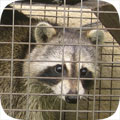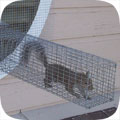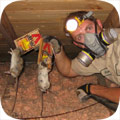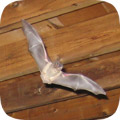- greensboro@wildlifeanimalcontrol.com
Call 24/7 for a free quote:
706-671-6075
Greensboro Wildlife Animal Control
Professional Wildlife Removal Company Servicing Greensboro, GA
If you have a problem with wildlife in your Greensboro home, your best option is to hire a company that specializes in Georgia wildlife removal only. This is a specialty business, and regular pest control companies do not use the proper techniques to solve animal problems. I have spent many years reviewing Georgia and Greensboro, and I recommend the following:
Active Pest Control
Cell Phone: 706-671-6075
NOTE: If you have a dog or cat problem, call Greene County Animal Services: (706) 454-1508

Active Pest Control specializes primarily in removing animals from attics of homes and buildings - this includes squirrels in attics, raccoons, and rats or mice in homes. Georgia also has a documented problem with
bats in buildings, and Active Pest Control is specially trained in bat removal. They also perform general wildlife trapping services, such as the capture and removal of skunks or opossums on the
property. Call 706-671-6075 to discuss your critter problem and schedule a same-day or next-day appointment. Click here to learn more about
what prices we charge in 2025.
When hiring a company to solve your wild animal problem, you want these features:
- Specializes in wildlife removal, not pest control
- Fully Georgia and Greene County licensed and insured
- Works 7 days per week (critters don't take weekends off)
- Performs full building inspections: enters and inspects attic
- Performs exclusion repairs, with guarantee against animal re-entry
- Offers cleanup of biohazardous wildlife waste
Active Pest Control is a full-service Greensboro wildlife removal company. This is very different from a regular Greensboro pest control company. The pest control companies spray poison to kill insects. This is not at all
similar to wildlife removal. Active Pest Control performs a full inspection of the home or property, and determines why the animal(s) are there, and if inside a building, how the animals got inside. All
animals (including rodents) are trapped and removed, or if possible, removed from the building using special exclusion devices. Once the animals are gone, preventative repairs are essential, and
cleanup is sometimes recommended.
 Greensboro wildlife trapping - it's not as simple as it may seem. It's illegal in Georgia to trap without a license. Trap type is very important and there are many different types, bait is somewhat relevant, trap placement
is vital, and there are dozens of small things that are very important to know.
Safety is a concern. Then once the animal is trapped, it must be removed and dealt with in the proper manner according to Georgia law. We offer Greensboro raccoon removal. Read more about how to get rid of raccoons.
Greensboro wildlife trapping - it's not as simple as it may seem. It's illegal in Georgia to trap without a license. Trap type is very important and there are many different types, bait is somewhat relevant, trap placement
is vital, and there are dozens of small things that are very important to know.
Safety is a concern. Then once the animal is trapped, it must be removed and dealt with in the proper manner according to Georgia law. We offer Greensboro raccoon removal. Read more about how to get rid of raccoons.
 Animals in attics - this is our specialty at Active Pest Control. Many types of animals like to live in attics. This includes squirrels, raccoons, rats, mice, bats, birds, and even possums. Critters like to go into attics for a safe place to live
and raise their young. Removing animals from attics is very complex work, partly because of the presence of baby animals. If you need Greensboro squirrel removal, we can remove all the squirrels from your attic, and seal out any future ones. Read more about how to get rid of squirrels.
Animals in attics - this is our specialty at Active Pest Control. Many types of animals like to live in attics. This includes squirrels, raccoons, rats, mice, bats, birds, and even possums. Critters like to go into attics for a safe place to live
and raise their young. Removing animals from attics is very complex work, partly because of the presence of baby animals. If you need Greensboro squirrel removal, we can remove all the squirrels from your attic, and seal out any future ones. Read more about how to get rid of squirrels.
 Rodent control must be done in a very specific way. First off, the most important thing is that all the openings that rats and mice can use to enter a house be sealed. Then all the rodents must be physically trapped and removed.
Never, ever use poison! Most Greensboro exterminators will just use this lazy poison technique to kill rodents, and it causes more harm than good - dead stinky rats, and it doesn't solve the problem. Call us for correct Greensboro rat removal. Read more about how to get rid of rats.
Rodent control must be done in a very specific way. First off, the most important thing is that all the openings that rats and mice can use to enter a house be sealed. Then all the rodents must be physically trapped and removed.
Never, ever use poison! Most Greensboro exterminators will just use this lazy poison technique to kill rodents, and it causes more harm than good - dead stinky rats, and it doesn't solve the problem. Call us for correct Greensboro rat removal. Read more about how to get rid of rats.
 Bat removal is a highly specialized task. Georgia is known to have colonizing bats who often live in buildings. Bats love attics. If not removed, the colony can grow to a very large size over the years. The bat droppings are often corrosive and
cause health risks. The same goes for bird droppings on or in buildings. We perform Greensboro pigeon removal and bird control. But our specialty is Greensboro bat removal. We remove 100% of the bat colony and seal the building so that it's totally bat-proof. Read more about how to get rid of bats.
Bat removal is a highly specialized task. Georgia is known to have colonizing bats who often live in buildings. Bats love attics. If not removed, the colony can grow to a very large size over the years. The bat droppings are often corrosive and
cause health risks. The same goes for bird droppings on or in buildings. We perform Greensboro pigeon removal and bird control. But our specialty is Greensboro bat removal. We remove 100% of the bat colony and seal the building so that it's totally bat-proof. Read more about how to get rid of bats.
 If you have animals inside a house, no job is complete without proper exclusion repairs. If you simply hire a Greensboro trapper who only removes the critters, then the problem will return. You need to hire a Greensboro wildlife control company that identifies 100% of the animal entry points
into your building, and seals them shut with professional repairs. In addition, in many cases animals have left waste or contamination behind, and you'll want a company that can provide professional cleaning services. Active Pest Control does both.
If you have animals inside a house, no job is complete without proper exclusion repairs. If you simply hire a Greensboro trapper who only removes the critters, then the problem will return. You need to hire a Greensboro wildlife control company that identifies 100% of the animal entry points
into your building, and seals them shut with professional repairs. In addition, in many cases animals have left waste or contamination behind, and you'll want a company that can provide professional cleaning services. Active Pest Control does both.
The above are just some of the services offered by Active Pest Control. We also trap and remove animals that destroy lawns, such as moles, or digging animals. Sometimes animals like opossums will live under buildings, steal pet food, raid garbage cans, etc.
Read about how to get rid of opossums. Skunks commonly live under sheds or decks, and set up a den. We can trap and remove them without them spraying. Read about how to get rid of skunks. Active Pest Control
also provides dead animal removal in Greensboro. If you need help with any other wildlife conflict, from a fox, beaver, groundhog, or any other critter, we can solve it. We also do Greensboro snake removal - most of the snakes in Georgia are not venomous, but
call us if you want safe removal, or read about how to get rid of snakes in Greensboro. And remember, we are a private business, not Greene County Animal Control Services, so if you have a dog or cat problem, call the County at (706) 454-1508.
Greene County animal services does not handle any wildlife issues.
Active Pest Control
Cell Phone: 706-671-6075
Greensboro Pricing Info
Every wildlife removal situation is different, from the species of animals involved, the location of the animal inside a house or outside, the extent of repairs or cleanup, etc. It's impossible to give one-size-fits-all prices. Examples MIGHT include:Small Job: For example, a one-stop job to remove an animal in the yard: $100 on up
Medium Job: For example, getting critters out of your house with minor repairs: $300 on up
Large Job: For example, a project involving many service trips and complex work: $500 on up
Give us a phone call now and tell us about your wildlife issue and we will be able to give you a price estimate over the phone. If you're cool with it, we can schedule a same-day or next-day appointment if you like. Our prices are fair, and a good value because we do the job right, the first time.
Greensboro Wildlife Tip #1:
About Beaver: Appearance, Biology, Life Cycle, Habitat, Diet, Behavior
Beaver, one of the largest rodents of North America is built to live in the water and is popular to build dam on the rivers and streams for living. Here are all the details of this animal to help you have a better idea about them.
Appearance
The beaver can weigh up to 60 pounds with a height of 4 feet. This animal has a long and flat hairless tail that they use for maintaining balance while climbing up the tress or else to warn away the predators while swimming on the water. Their front legs are short with heavy claws while the rear legs are larger. The rear webbed hinds are used to propel when they are in water. The ear and nose remain closed under water while the eyes are covered with some special membrane. They have fur all over the body, while the fur is of dark brown color in the back, the belly and chest have light brown color fur.
Biology
This creature is slow at the land but is very fast under water and can stay under water for long 15 minutes. They create a sound alarm when frightened or startled and dive into the water rapidly with their broad tail slapping in the water. The noise is very loud that is heard from long distances and once other beavers get this noise they too dive and do not emerge for few minutes.
Life cycle
Beaver can live for 20 years and their mating is started as they age 3 years. January and March is the time when they mate for life and their gestation lasts for 3 months. The female beaver gives birth to one litter between April and June every year. The young beaver lives with their parents for the first two years but can swim just after 24 hours of their birth.
Habitat
Beavers prefer to live near rivers, small lakes, streams, ponds and marshes. Most of them build a lodge while very few of them build burrows on the river bank for staying.
Diet
Tree bark is their main diet and the bark of maple, willow, birch, beech, aspen, cottonwood and alder trees are included in their diet. However they also use to have other vegetation such as bud, roots and other water plants.
Behavior
This animal loves to live with their family group such as male, female and offspring. They mark their territory greatly creating a barrier of mud and using some scent while they protect their lodges from other beavers also.
Greensboro Wildlife Tip #2:
Georgia Wildlife Information:
Georgia State bird: Brown thrasher
State mammal: Right whale
State reptile: Gopher tortoise
State amphibian: American green tree frog
State fish: Largemouth bass
State insect: European honeybee
There are many delightful things about Georgia. The landscape is thick with vegetation, primarily due to the significant amount of precipitation annually and the hot temperatures. Even in the northern mountains, the days are long and hot, often interrupted by brief spats of rain. Forest and field thrive here, and Georgia is also home to one of the places in the country teeming with wildlife: Okefenokee Swamp. The swamp, which consists of 438,000 acres of marshland, is home to over 200 species of birds, 50 mammal species, 64 reptile species, 39 fish species, and 37 species of amphibian. Of those animals, the largest are the alligators and the black bears. These predators have no trouble locating food within the park's boundaries. Smaller animals, like raccoons, feed off of the eggs laid by marsh birds and reptiles alike. Not surprisingly, dangerous animals, like the cottonmouth snake, also make the swamp home.
Though filled with animals, the swamp makes up only a small part of Georgia. The rest of the state is just as populated with critters, and because it is also densely populated with people, clashes between the species are inevitable.
Alligators are not confined to Okefenokee Swamp. These large reptiles have no fear of humans, and they make their homes in any waterway where food is present. People living near rivers and streams must always be on the lookout for the dangerous alligator; the animal is almost invisible when underwater.
Even common pest animals fall prey to alligators. Raccoons, which are frequent invaders of homes, can get too close to the water's edge and be snatched up as a meal. This is one reason why it is important to keep pest animals like armadillos, raccoons, rats, squirrels, and skunks off of your property. Sometimes they will lure in larger, more fearsome creatures.
Rats and other scavengers are common in Georgia. The heat amplifies the odors of discarded food, and it doesn't take long in the summer sun for a rat, opossum, or raccoon to wander into the yard looking for the compost pile or the open garbage bin. Pet food is another aromatic lure for these small creatures. The nights in Georgia are not cool enough to temper a smell, and many pests wait until after dark to strike.
You can always call Active Pest Control, any time of day, at 706-671-6075, for a price quote for Greensboro wildlife control services. I am confident that this is the best choice amongst wildlife removal companies in Greensboro, GA.







































